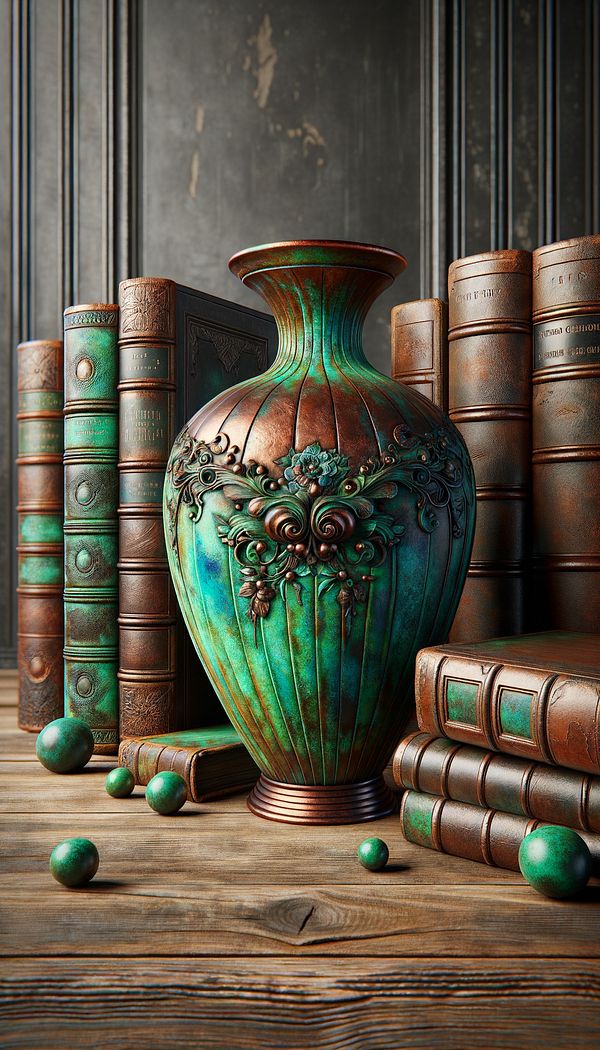What is a Patina?
Patina is a thin layer that forms on the surface of copper, bronze, and similar metals (due to oxidation), or on wooden and leather surfaces through aging, wear, and exposure.
Description
Patina is a term that evokes a sense of timelessness and natural beauty in the realm of interior design. It refers to the unique surface texture and coloring that materials such as metal, wood, and leather acquire over time, as a result of exposure to various environmental conditions, including air, light, and moisture. This process can also be chemically induced or accelerated to achieve a specific aesthetic. Unlike other forms of wear, which might diminish the appearance or value of items, patina is often highly sought after, as it adds character, warmth, and a story to an object or surface.
In interior design, patina is not only embraced but celebrated as a design feature that adds depth and rich history to a space. It is synonymous with well-loved and well-used items that boast an elevated level of craftsmanship and quality. The appeal of patina lies in its ability to bring a grounded, organic, and textural element to interiors, bridging the gap between the new and the old. Patina can also reflect a sustainable and eco-conscious approach to design, as it encourages the appreciation and repurposing of older, aged pieces rather than contributing to a culture of disposability.
Usage
Patina is widely applicable across various elements of interior design, from the lustrous green layer that forms on the surface of copper fixtures and decorative objects, giving them an antique look, to the rich, warm hues that develop on hardwood flooring or leather sofas over time. It is often integral to design styles that prioritize authenticity, history, and texture, such as vintage, industrial, or rustic aesthetics. Patina can also be deliberately introduced to new items through various finishing techniques, offering a way to infuse modern pieces with a sense of history and character.
FAQs
-
How does patina form?
Patina forms naturally over time as materials are exposed to air, moisture, and light. For metals like copper and bronze, this results in oxidation, which leads to a change in color and texture. On wood and leather, wear and exposure contribute to a patinated appearance. It can also be chemically induced or accelerated to achieve a desired effect.
-
Is patina considered a flaw?
Not at all! In the world of interior design, patina is often viewed as a desirable attribute that adds character, depth, and a sense of history to an item or surface. It's appreciated for its beauty and the unique quality it brings to materials.
-
Can patina be replicated on new items?
Yes, patina can be artificially introduced to new items through various techniques, including chemical treatments for metals, or through manual aging processes for materials like wood and leather. These techniques allow designers to achieve a vintage or aged look on newer pieces.
Practical Application
Embracing patina in your design projects involves recognizing the beauty in aging and imperfection. Consider incorporating aged metals, distressed wood, or leather with a natural patina in your spaces to add depth and character. You can also explore artificial patination techniques to introduce this aesthetic to newer items. Whether naturally occurring or artificially induced, patina can add a timeless charm and a layer of richness to your interior designs.
-
Architectural Elements199 articles
-
Design Styles478 articles
-
Furniture Types599 articles
-
Decorative Techniques322 articles
-
Materials & Textiles360 articles
-
UrnAn urn is a decorative container often used for displaying flowers or for ornamental purposes.
-
Console TableA console table is a narrow, long table typically placed against a wall.
-
Accent WallAn accent wall is a wall that is designed to stand out from the surrounding walls in a room.
-
IslandAn island is a standalone work station or storage area within a room, often found in kitchens.
-
CommonwealthCommonwealth does not have a specific meaning in interior design.
